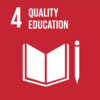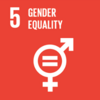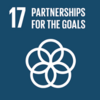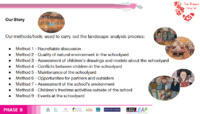LED2LEAP 2021 - Budapest Community Living Lab
The LADDER Living Lab
This is a laboratory with students for supporting a democratic environment. Our partners include:
- The Hungarian University of Agriculture and Life Sciences, Institute of Landscape Architecture, Urban Planning and Garden Art
- kultúrAktív Association
- Budaörs No.1 Primary School
- Dr. Ámbedkar School, Miskolc
- Polytechnic of Economics, Budapest
- Hristo Botev Primary School, Veszprém
- Jendrassik-Venesz High School and Vocational School, Veszprém
Who is Involved?
- Staff, students (Bsc, Msc, MA, PhD) and volunteers from the university
- Staff and volunteers of the NGO kultúrAktív
- Students, teachers & staff and parents from the schools
- Local architects, landscape architects, teachers, pedagogues, educators, etc.
The Living Lab engages different school communities (students, teachers and parents) from Hungary. Primary and secondary schools are involved as well, with different social backgrounds.
Main Theme of the Living Lab
The Hungarian project team has formed a living lab called LADDER, which is a mosaic word in Hungary for Laboratory with Students for Democratic Environment. The LADDER project aims to popularize democratic schoolyard design and connect academia with school communities through a children and youth-centered community design process in which built environment educators, the school community (teachers, students, parents, etc.) and the landscape architecture profession (university teachers and students) work together to map, assess, envision and co-design the school environment.
The main activities of the Living Lab are the following:
● Rethinking and renovating school environments with the involvement of the school community, especially young people
● Development and application of a board game for community design in schoolyards
● Methodological guidance for collective mapping, planning, implementation and maintenance
Methods
The LADDER Living Lab is an exploratory collaboration space that allows continuous reflection and improvements of participatory methods through a combination of research and innovation processes within a mid-term partnership between the University, the NGO kultúrAktív and various local school partners. The lab is a user-centered, open-innovation ecosystem, operating in a territorial context of Hungary and with a thematic focus on democratic school environment redevelopment. Living labs operate with an iterative Participatory Action Research methodology that systematically provides solutions for locally identified issues through a cycle of: co-creation, exploration, experimentation, prototyping, and evaluation. Due to COVID-19, some of the collaboration activities are done remotely. The participatory design process in the LADDER Living Lab is not limited to co-design but it also focuses on collaborative mapping, assessment, goal setting, testing and collective evaluation of the schoolyard. As in each phase we have special needs and aspects that should be underlined, identification of the characteristics and the benefits of each methodology and analysing in which phase of the participatory process it fits the best is a primary question.
Collaborations
Collaboration with No. 1. Primary School, Budaörs
Method:
● Remote/online participatory planning
● 3 action days - collective analysis, visioning and prototyping
● Dream Schoolyard drawing and modelling competition and exhibition
● Collective evaluation (Urbanity game)
Outputs & outcomes:
● Small interventions based on students’ ideas
● Implementation plan to realise in the schoolyard
● Student council became responsible for schoolyard
● Booklet about the process, methods and evaluation to be published soon
Collaboration with Dr. Ámbedkar School, Miskolc
Method:
● 2 workshops, 10-days intensive program with disadvantaged community
● from collective visioning & decision making to acting together
Outputs & outcomes:
● booklet to introduce the process, tools & methods and to conclude the findings and lessons learnt
● maintaining the implemented garden features
● full renovation of the building facade and the fence
● initiating a sculpture placement to create identity
Collaboration with Polytechnic of Economics, Budapest
Method:
● environmental education program led by university students to teach and learn about landscape (LA Masters, 4 occasions)
● using the design-based learning and learning-by-doing methods, and the 4C (communication, collaboration, critical thinking, and creativity) principles
● design workshop week at the university to create conceptual plans
● collective site analysis: students and teachers were involved
Outputs & outcomes:
● several prototypes for ideas
● exhibition from the ideas
● 9 conceptual plan for the schoolyard made by university students
Future aims:
● implementing ideas collectively
● booklet to conclude lessons learnt
Boardgame development
Goal:
to create a boardgame for school kids to make them aware of their school environments and show them possibilities to improve their own environments by themselves, by small actions
Method:
● elective course at the university for landscape architect students - 3 courses (2 years)
● partly an online process (via zoom and mural)
● continuous game testing in 5 schools
Outputs & outcomes:
● 2 board games for 2 different age groups (7-18, 12-18 years)
Future aims:
● publish and use the boardgame in participatory projects
Project Location & Dissemination
Location of the Living Lab includes Budapest, Budaörs, Miskolc and Veszprém
- Dissemination on the NGO website - kulturAktiv project site for LED2LEAP
- Dissemination on the university website – MATE project site for LED2LEAP
- Articles about the online tools and methods used in the 1st year of the collaboration with the Budaörs No1 Primary School - Article 1 Article 2
- Paper in the Journal of Digital Landscape Architecture (2021) - Report of a Remote Participatory Design Process to Renew a Schoolyard During COVID-19
- With Children in All Spaces Webinar - Mapping and Analysis with Kids, Prioritizing and Brainstorming with Youth, Collaborative Design and Realization
- With Children in All Spaces I. Online and offline community planning with young people. Tips and methodology for transforming young people’s outdoor spaces for teachers and designers.
- With Children in All Spaces II-III. booklets (to be published)
- Booklet about partnership with Dr. Ámbedkar School: Demokratikus tájépítészet iskolai környezetben I. Együttműködés a miskolci Dr. Ámbédkar Iskolával
- Booklets about other partnerships (to be published)
- ISP booklet: PARTNERING FOR LANDSCAPE DEMOCRACY. An Intensive Study Program in Miskolc to renew the school environment of the Dr. Ámbédkar School, 2021
- Conference presentation: The case study of the LADDER – Laboratory with Students for Democratic Environment, project in Hungary. 10th Child in the City World Conference 5-7 October 2022 Dublin, Ireland
- Development of 2 board games for collaborative schoolyard design (to be published)
















